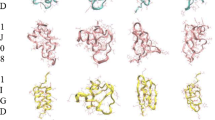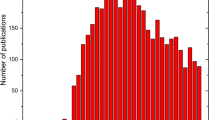Abstract
The vast majority of theoretical and experimental folding studies have shown that as a protein folds, it attempts to adopt a conformation that occurs at its lowest free energy minimum. However, studies on a small number of proteins have now shown that this is a generality. In this review we discuss recent data on how two proteins, α-lytic protease and α1-antitrypsin, successfully fold to their metastable native states, whilst avoiding more stable but inactive conformations.



Similar content being viewed by others
References
Anfinsen CB (1973) Science 181:223–230
Baker D, Agard DA (1994) Biochemistry 33:7505–7509
Baker D, Sohl JL, Agard DA (1992) Nature 356:263–265
Berkenpas MB, Lawrence DA, Ginsburg D (1995) Embo J 14:2969–2977
Bruch M, Weiss V, Engel J (1988) J Biol Chem 263:16626–16630
Bullough PA, Hughson FM, Skehel JJ, Wiley DC (1994) Nature 371:37–43
Cabrita LD, Whisstock JC, Bottomley SP (2002) Biochemistry 41:4575–4581
Carrell RW, Gooptu B (1998) Curr Opin Struct Biol 8:799–809
Carrell RW, Stein PE, Fermi G, Wardell MR (1994) Structure 2:257–270
Chan DC, Fass D, Berger JM, Kim PS (1997) Cell 89:263–273
Cunningham EL, Jaswal SS, Sohl JL, Agard DA (1999) Proc Natl Acad Sci USA 9:11008–11014
Cunningham EL, Mau T, Truhlar SM, Agard DA (2002) Biochemistry 41:8860–8867
Dafforn TR, Mahadeva R, Elliott PR, Sivasothy P, Lomas DA (1999) J Biol Chem 274:9548–9555
Daggett V, Fersht AR (2003) Trends Biochem Sci 28:18–25
Devlin GL, Chow MK, Howlett GJ, Bottomley SP (2002) J Mol Biol 324:859–870
Dobson CM (2001) Philos Trans R Soc Lond B Biol Sci 356:133–145
Elliott PR, Abrahams JP, Lomas DA (1998) J Mol Biol 275:419–425
Fish WW, Danielsson A, Nordling K, Miller SH, Lam CF, Bjork I (1985) Biochemistry 24:1510–1517
Fujinaga M, Delbaere LT, Brayer GD, James MN (1985) J Mol Biol 184:479–502
Gooptu B, Hazes B, Chang WS, Dafforn TR, Carrell RW, Read RJ, Lomas DA (2000) Proc Natl Acad Sci USA 97:67–72
Herve M, Ghelis C (1990) Eur J Biochem 191:653–658
Horwich A (2002) J Clin Invest 110:1221–1232
Huntington JA, Read RJ, Carrell RW (2000) Nature 407:923–926
Im H, Yu MH (2000) Protein Sci 9:934–941
Im H, Seo EJ, Yu MH (1999) J Biol Chem 274:11072–11077
Im H, Ahn HY, Yu MH (2000) Protein Sci 9:1497–1502
Im H, Woo MS, Hwang KY, Yu MH (2002) J Biol Chem 277:46347–46354
Irving JA, Pike RN, Lesk AM, Whisstock JC (2000) Genome Res 10:1841–1860
Irving JA, Steenbakkers PJ, Lesk AM, Op den Camp HJ, Pike RN, Whisstock JC (2002) Mol Biol Evol 19:1881–1890
Irving JA, Cabrita LD, Rossjohn J, Pike RN, Bottomley SP, Whisstock JC (2003) Structure (Camb) 11:387–397
James EL, Bottomley SP (1998) Arch Biochem Biophys 356:296–300
James EL, Whisstock JC, Gore MG, Bottomley SP (1999) J Biol Chem 274:9482–9488
Jaswal SS, Sohl JL, Davis JH, Agard DA (2002) Nature 415:343–346
Kaslik G, Patthy A, Balint M, Graf L (1995) FEBS Lett 370:179–183
Kwon KS, Kim J, Shin HS, Yu MH (1994) J Biol Chem 269:9627–9631
Lee C, Park SH, Lee MY, Yu MH (2000) Proc Natl Acad Sci USA 97:7727–7731
Lee KN, Park SD, Yu MH (1996) Nat Struct Biol 3:497–500
Liu T, Pemberton PA, Robertson AD (1999) J Biol Chem 274:29628–29632
Loebermann H, Tokuoka R, Deisenhofer J, Huber R (1984) J Mol Biol 177:531–557
Lomas DA, Evans DL, Finch JT, Carrell RW (1992) Nature 357:605–607
Lomas DA, Evans DL, Stone SR, Chang WS, Carrell RW (1993) Biochemistry 32:500–508
Mahadeva R, Dafforn TR, Carrell RW, Lomas DA (2002) J Biol Chem 277:6771–6774
Mast AE, Enghild JJ, Salvesen G (1992) Biochemistry 31:2720–2728
Orosz A, Wisniewski J, Wu C (1996) Mol Cell Biol 16:7018–7030
Pearce MC, Rubin H, Bottomley SP (2000) J Biol Chem 275:28513–28518
Peters RJ, Shiau AK, Sohl JL, Anderson DE, Tang G, Silen JL, Agard DA (1998) Biochemistry 37:12058–12067
Powell LM, Pain RH (1992) J Mol Biol 224:241–252
Sauter NK, Mau T, Rader SD, Agard DA (1998) Nat Struct Biol 5:945–950
Silen JL, McGrath CN, Smith KR, Agard DA (1988) Gene 69:237–244
Silen JL, Frank D, Fujishige A, Bone R, Agard DA (1989) J Bacteriol 171:1320–1325
Silverman GA, Bird PI, Carrell RW, Church FC, Coughlin PB, Gettins PG, Irving JA, Lomas DA, Luke CJ, Moyer RW, Pemberton PA, Remold-O'Donnell E, Salvesen GS, Travis J, Whisstock JC (2001) J Biol Chem 276:33293–33296
Sivasothy P, Dafforn TR, Gettins PG, Lomas DA (2000) J Biol Chem 275:33663–33668
Sohl JL, Shiau AK, Rader SD, Wilk BJ, Agard DA (1997) Biochemistry 36:3894–3902
Sohl JL, Jaswal SS, Agard DA (1998) Nature 395:817–819
Stein PE, Carrell RW (1995) Nat Struct Biol 2:96–113
Stiasny K, Allison SL, Mandl CW, Heinz FX (2001) J Virol 75:7392–7398
Stratikos E, Gettins PG (1999) Proc Natl Acad Sci USA 96:4808–4813
Tew DJ, Bottomley SP (2001a) FEBS Lett 494:30–33
Tew DJ, Bottomley SP (2001b) J Mol Biol 313:1161–1169
Wang Z, Mottonen J, Goldsmith EJ (1996) Biochemistry 35:16443–16448
Whisstock J, Skinner R, Lesk AM (1998) Trends Biochem Sci 23:63–67
Ye S, Cech AL, Belmares R, Bergstrom RC, Tong Y, Corey DR, Kanost MR, Goldsmith EJ (2001) Nat Struct Biol 8:979–983
Yu MH, Lee KN, Kim J (1995) Nat Struct Biol 2:363–367
Acknowledgements
SPB would like to thank members of his laboratory for their time and effort. SPB is a Monash University Senior Logan Research Fellow and an RD Wright Fellow of the NH&MRC. This work is supported by the NH&MRC and the Australian Research Council.
Author information
Authors and Affiliations
Corresponding author
Rights and permissions
About this article
Cite this article
Cabrita, L.D., Bottomley, S.P. How do proteins avoid becoming too stable? Biophysical studies into metastable proteins. Eur Biophys J 33, 83–88 (2004). https://doi.org/10.1007/s00249-003-0356-1
Received:
Accepted:
Published:
Issue Date:
DOI: https://doi.org/10.1007/s00249-003-0356-1




